Kate Harris
Social Studies teacher
Pittsburgh CAPA
Middle School (13 to 15 years old), High School (16 to 18 years old)
Teacher/Educator
Language Arts And English, Civics, Literature, Cultures, Economics, Social Studies, Geography, Writing, US History, Arts, Other
I'm a history-lover, art fan, and bookworm. I taught high school history (U.S. History and World Religions) for ten years in North Carolina, teach currently in Pittsburgh, PA, and am working to help teachers make the most of this new resource!
Kate Harris's collections
Attention-grabbing headlines don't always tell truth!
<p><strong>Attention-grabbing headlines don't always tell truth!</strong></p><p><strong>Pictures are powerful, sometimes edited!</strong></p><p><strong>Twitter doesn't tell whole story.</strong></p><p><br /></p><p>In the era of "fake news" and information overload, we all need to become better readers of the words and pictures that are used to explain what is going on in the world around us. In this activity, students and teachers will consider:</p><p><strong>How<span></span></strong><strong> can the choice of image or words convey different messages about current events? How do journalists and editors shape the news through their choices?</strong><br /></p><p>This student activity asks students to look at several images of young people resisting a law or recent event. Their task is to write two different headlines for that image designed to appeal to different audiences. They will also be asked to research the context for the image and to consider how that might impact their headlines. </p><p>The goals of this lesson are to:</p><ul><li>explore image and word choice as news drivers (factors that make items newsworthy or appealing to readers)</li><li>determine how journalists and editors shape the news through their choices</li><li>encourage news literacy and a critical reading of headlines and photojournalism in the future. </li></ul>
 Kate Harris
Kate Harris
15
Forced Removal during Apartheid: Examining Historic Photographs
<p><em>How did apartheid affect the lives of blacks living in Johannesburg in the late 1940s and early 1950s? What was the purpose of forced removal?</em></p><p>This student activity uses the examination of historical photographs as an entry point to learning about the forced removal of blacks from urban areas to townships & homelands under apartheid in South Africa. The images here are all from Sophiatown and Soweto. What details emerge about the life changes that resulted from being moved? What questions remain?</p>
 Kate Harris
Kate Harris
19
Timeline: Causes of the Civil War
<p>This collection includes artifacts, stamps, political cartoons, portraits, and videos representing various long-term and short-term causes of the Civil War. After reviewing the collection, students will sort resources into chronological order, focusing on continuity and change over time. </p><p>Tags: compromise, Civil War, John Brown, Fort Sumter, Ft, Abraham Lincoln, Sumner, Brooks, Taney, Dred Scott, 1850, 1860, secession</p><p><br /></p><p>Additional teaching ideas are listed in the Notes to Other Users section.</p>
 Kate Harris
Kate Harris
30
Globalization and Cultural Diffusion
<p>This student activity focuses on the concepts of globalization and cultural diffusion. Students will look at a variety of artifacts and explain how they illustrate the two concepts and/or help answer the guiding questions below:</p><ul><li>What is globalization and how does it affect people and places?</li><li>What leads to cultural diffusion?</li></ul>
 Kate Harris
Kate Harris
10
Sorting Activity New Deal Organizations: Relief, Recovery, or Reform?
<p>First, review the images in the collection and the information provided with each, then determine which New Deal organization it is representing. Think about whether that organization is a good example of relief, recovery, or reform. At the end of the collection, you will be asked to sort the images into categories and answer some evaluative questions.</p>
<p><br /></p>
<p>tags: Great Depression, FDR, Roosevelt, New Deal, Agricultural Adjustment Act, Tennessee Valley Administration, 1930s, sort</p><p><em>#historicalthinking</em></p><p><br /></p>
 Kate Harris
Kate Harris
23
The Fight to End Apartheid
<p>This is a topical collection of resources related to the fight to end apartheid. Teachers and students can use this collection to explore strategies used to fight against apartheid as well as famous leaders in the fight. Strategies include economic sanctions, boycotts, and divestment, raising awareness through artists and musicians, nonviolent protest, armed resistance, and external political pressures on the South African government. This is a work-in-progress based on the digitized materials within the Smithsonian Learning Lab's collection--it is not meant to be wholly definitive or authoritative. Think of it as a starting point for further inquiry!</p><p>Possible student activities include:</p><p>-researching one strategy of resistance and/or one well-known leader in depth.</p><p>-drawing comparisons between political organizations and movements like the ANC, PAC, Black Consciousness Movement, and United Democratic Front.</p><p>-creating a timeline of resistance to apartheid.</p><p>-debating the use of armed resistance and "sabotage."</p><p>-interviewing adults who may remember the end of apartheid.</p><p>-drawing comparisons between the civil rights movement in the United States and the anti-apartheid movement.</p><p>-choose 1-3 events and make a case for them as turning points in the fight against apartheid. What makes these events so significant?</p><p>tags: apartheid, South Africa, Mandela, Tutu, Huddleston, Soweto, townships, Sharpeville, Defiance Campaign, Biko</p>
 Kate Harris
Kate Harris
28
The Steamboat Arabia
<p style="margin-left:32px;">This collection was made to pair with a learning experience during the November 17th workshop for Pittsburgh teachers working with the Smithsonian Learning Lab. Teachers will visit the Steamboat Arabia exhibit and learn from a Heinz History Center curator about the decisions made and limitations faced when creating an exhibit for visitors to learn from. </p><p style="margin-left:32px;">Both the online collection and the Heinz History Center exhibit explore the question "<strong>How do new innovations in transportation affect American life?"</strong></p><p style="margin-left:32px;">The collection below contains artifacts and images from the Smithsonian collection that might help students and teachers respond to the question above. Suggested scaffolding questions might include:</p><ul><li>Identify the changes in technology and transportation that occurred between 1800-1850.</li><li>How did these new transportation systems impact the movement and interactions of groups of people, the expansion of trade, and cultural life on the frontier?</li><li>How do the items in this collection compare to what was found during the recovery of the Steamboat Arabia?</li></ul>
 Kate Harris
Kate Harris
22
3D Technology and Repatriation of the Kéet-S’aaxw
<p>This student activity introduces students to the concept of repatriation of cultural heritage items to the tribes to whom they belong, and the ways that museums and Native American groups are now using 3D technology to aid in the process. A killer whale hat, or kéet-s'aaxw, was requested to be repatriated by members of the Tlingit tribe. The Smithsonian Institution, under the repatriation provisions of the National Museum of the American Indian Act, did so. In the years following, the clan's leader decided that it might be beneficial to 3D scan the image in order to preserve its details and protect it in case of loss or fire. Having this data allowed the museum to create an accurate replica to be used for educational purposes, and provided the tribe with peace of mind. Learn more about this story and other cases of repatriation and replication in this collection which includes a 3D model and tour, video, website, and images of objects that have been part of the process. </p>
<p>Essential Questions include:</p>
<ul><li>How does the current process of repatriation reflect a change in traditional relationships between museums and indigenous groups?</li><li>What kinds of guidelines should be used to determine which objects should be repatriated?</li><li>What benefits does 3D technology provide for museums and Native American tribes? Can you envision other scenarios where 3D technology might play a similarly beneficial role?</li></ul><p>Tags: Native American, American Indian, Tlingit, repatriation, replication, 3D technology, whale hat, indigenous, rights, change over time, museums, anthropology</p>
 Kate Harris
Kate Harris
10
3-D Resources from the Smithsonian
<p>This collection provides an introduction to the 3D resources available from the Smithsonian Institution. All of the items in this collection are videos showing 3D models or sharing the process of creating such materials. To explore the models directly in a 3D viewer, download file information, and discover tours and other educator resources, please visit <a href="http://3d.si.edu" target="_blank">3d.si.edu</a>.</p><p>Models of interest to K-12 teachers might include:</p><ul><li>Apollo 11 command module</li><li>Amelia Earhart's flight suit</li><li>Liang Bua (archaeological site where <em>homo floriensis</em> was discovered)</li><li>Funerary bust of Haliphat (from Palmyra)</li><li>Jamestown burial sites and artifacts</li><li>David Livingstone's gun</li><li>Porcelain dishes and other home items in the Freer Gallery of Art (from Asian cultures)</li><li>Killer Whale Hat</li><li>Whale and dolphin fossils</li><li>Cosmic Buddha</li><li>Woolly mammoth skeleton</li><li>Wright Brothers flyer</li><li>Gunboat Philadelphia</li></ul>
 Kate Harris
Kate Harris
19
The 1980s: A Decade Collection
<p>This is a topical collection about American life and politics in the 1980s. Resources in this collection might be helpful to students and teachers working on projects about the decade. It is not meant to be completely comprehensive, but rather includes highlights of the Smithsonian's collection spanning art, popular culture, social trends, leadership, and technology.</p><p>Teachers and students might copy and adapt this collection to suit their needs; highlighting a specific aspect of life in the 1980s and adding annotations and additional resources.</p><p>tags: Eighties, Reagan, George H. W. Bush, rap, detente, Vietnam, politics, decade, Cold War, Olympics, boycott, space shuttle, star wars, Reaganomics, trickle-down</p>
 Kate Harris
Kate Harris
42
Nixon in Political Cartoons
<p>This collection includes nine political cartoons about Richard Nixon's presidency and the Watergate scandal, as well as a cartoon analysis worksheet from the National Archives and Record Administration and a link to more cartoons about Nixon at the Library of Congress.</p><p>Teachers may use this collection in many ways: by assigning individual students or groups cartoons to analyze and share with the class via presentations, using the "jigsaw" format to create expert groups on each cartoon and then share information that way, or by creating a gallery walk of cartoons for students to work on individually. Students might even create their own political cartoon about the Nixon presidency, focusing on one of several topics: Watergate, ping-pong diplomacy, detente, visit to Moscow, environmental protections, the "southern strategy," busing, his relationship with the press, Vietnam, and more. </p>
 Kate Harris
Kate Harris
11
What were the causes of U.S. imperialism?
<p>This collection examines the causes of U.S. imperialism at the turn of the century through the lens of two political cartoons. Students will investigate both cartoons and develop a definition of imperialism based on what they find. </p>
 Kate Harris
Kate Harris
4








